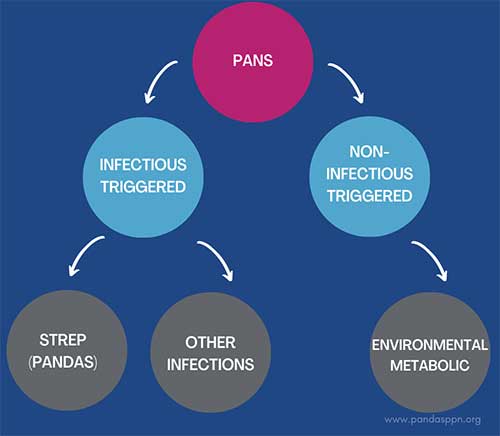UNDERSTANDING
PANS/PANDAS
What are the symptoms of PANS/PANDAS?
The acute and dramatic onset of mood and behavioral changes are red flags of possible PANS and PANDAS.
The symptoms of PANS (Pediatric Acute-onset Neuropsychiatric Syndrome) include an acute onset of:
- OCD and/or
- Restrictive Eating Disorder
- PLUS additional symptoms from at least 2 of the following categories:
- Anxiety and/or separation anxiety
- Emotional lability and/or depression
- Irritability, aggression, and/or severe oppositional behaviors
- Behavioral regression
- Deterioration in school performance
- Sensory or motor abnormalities (including tics)
- Somatic signs and symptoms, including sleep disturbances or urinary frequency
PANS is thought to be an immune reaction to a number of physiological stressors including Group A Streptococcal infection, Mycoplasma pneumonia infection, influenza, upper respiratory infections, sinusitis, Lyme, and psychosocial stresses. PANS has no age limitation. Learn more about PANS at https://www.pandasppn.org/pans.
PANDAS (Pediatric Autoimmune Neuropsychiatric Disorders Associated with Streptococcal infections) is a subset of PANS. PANDAS has five distinct criteria for diagnosis, including:
- Abrupt OCD or dramatic, disabling tics
- A relapsing-remitting, episodic symptom course
- Young age at onset (average of 6–7 years)
- Presence of neurologic abnormalities
- Temporal association between symptom onset and Group A strep infection
The 5 criteria usually are accompanied by similar comorbid symptoms as found in PANS. Learn more about PANDAS at https://www.pandasppn.org/pandas.
THE HIERARCHY OF PANS

Is PANS/PANDAS the same as childhood OCD?
Why does the diagnosis matter?
PANS/PANDAS may be considered a form of Basal Ganglia Autoimmune Encephalitis. The presentation of PANS/PANDAS varies from traditional childhood OCD, and it has different treatment options. View the comparison chart to learn how PANS/PANDAS differs from traditional childhood OCD.
I suspect PANS/PANDAS.
What are the next steps?
Familiarize yourself with the PANS/PANDAS flowcharts.
The flowcharts for diagnosing and treating PANS and PANDAS walk you through evaluating patients for possible PANS/PANDAS then guides you through treatment considerations based on symptom severity.
Review Seeing Your First Child with PANDAS/PANS.
“Seeing Your First Child with PANDAS/PANS” is a medical guide consisting of: overview and current theories, PANDAS/PANS symptoms and diagnostic criteria, workup recommendations, and expectations.
Read the PANS Research Consortium papers.
The consensus paper and management recommendations include details on PANS/PANDAS treatment options including antibiotics to remove the source of inflammation (streptococcus or another infection), anti-inflammatories, IVIG, behavioral therapies, and more.
Access the PPN Practitioner Directory.
Primary care providers can diagnose PANS/PANDAS and implement the majority of treatments. If you need help finding a doctor or medical professional familiar with PANS/PANDAS, visit the PPN Practitioner Directory. Practitioners can request to be listed in the directory by becoming a member of the PPN.





